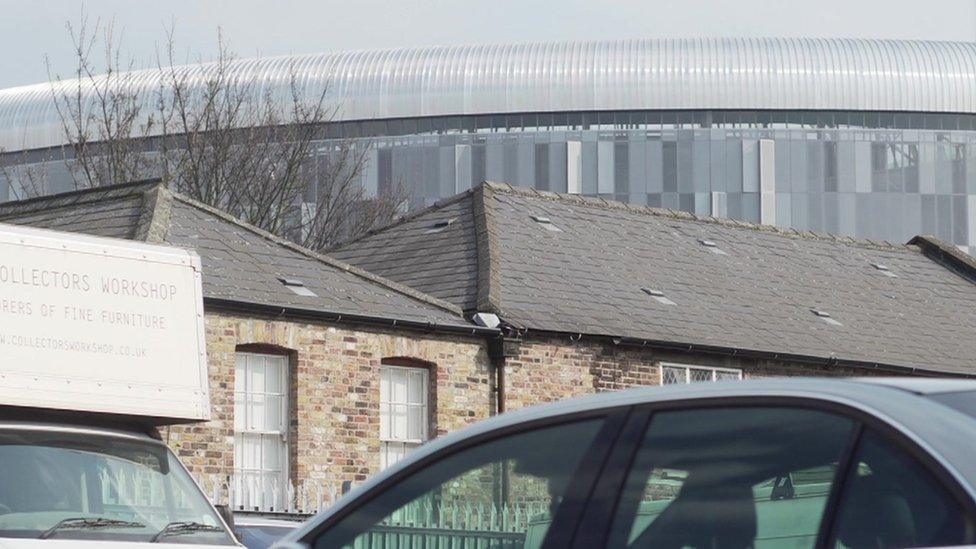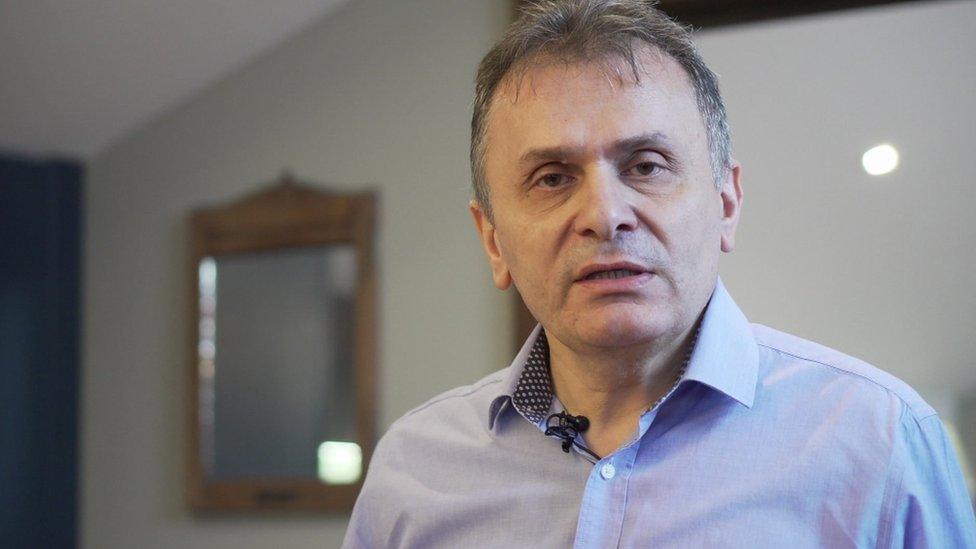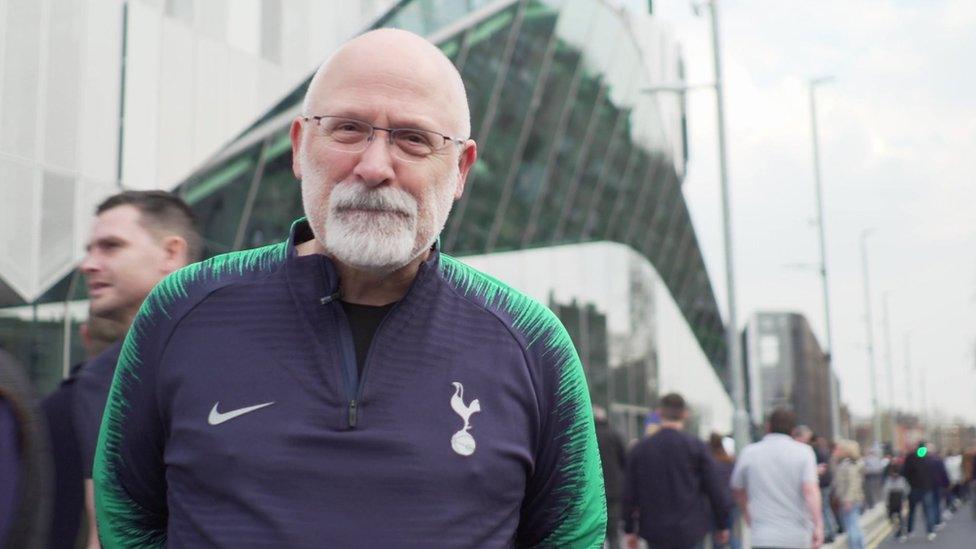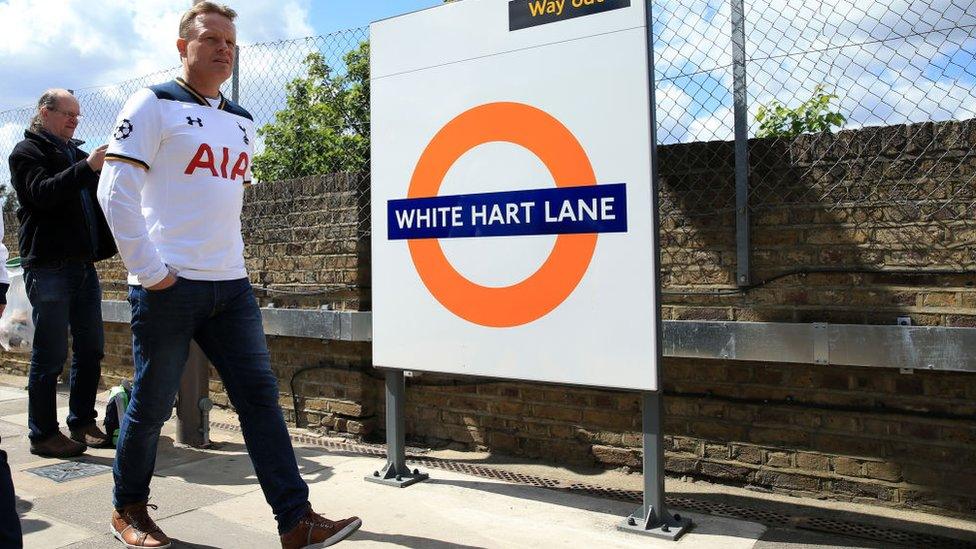Tottenham Hotspur Stadium: Living in the shadow of the new ground
- Published
Mixed feelings around Tottenham Hotspur's new home
Tottenham Hotspur have played their first Premier League match in their new £1bn stadium.
It has got a capacity of 62,062, state-of-the-art acoustics to boost atmosphere, and even its own microbrewery.
But some locals living in the shadow of the new ground have raised concerns about redevelopment projects.
The families

Natasha Thomas-Brown lives in a one-bedroom flat with her two children
Underneath the towering structure of the new stadium, Natasha Thomas-Brown lives in a one-bedroom flat on Love Lane Estate with her two children.
"I do like Tottenham Hotspur because I used to work there, and they promoted me quite quick," she says with a wide grin, while bouncing her baby boy on her lap.
But Ms Thomas-Brown, a healthcare assistant for the district nursing service, worries about the fact the new Tottenham Hotspur Stadium seats almost twice as many people as the old White Hart Lane ground.
"If they're blocking off certain roads then I'm not going to be able to get to patients on time," she said.
All 297 properties on the estate could be demolished to create a walkway between White Hart Lane Tube station and the stadium.
The plans are part of a regeneration scheme which Ms Thomas-Brown "embraces" because she thinks it could help to solve drug misuse in the area.

The huge Tottenham Hotspur Stadium towers over many north London homes
Secure council tenants from Love Lane will be offered one of the more than new 2,500 homes promised as part of the project.
But since Ms Thomas-Brown was only housed as part of the council's temporary accommodation scheme, she will have to find a new place to live.
The 29-year-old said: "I was misled being housed here, because when I signed my tenancy agreement I was told that people being housed into these buildings would be rehoused into the new builds."
After "months" of back-and-forth conversations about her options, Ms Thomas-Brown has blocked Haringey Council's number on her phone because she says they treat people "like numbers, not human beings".
The council said if the demolition goes ahead it would help all tenants to find somewhere to live.
The businesses

Faruk Tepeyurt says small businesses are being pushed out of the area by "gentrification"
A couple of minutes' walk from Spurs' new home, Faruk Tepeyurt co-owns Solmaz Ltd, a construction and joinery business on the Peacock Industrial Estate.
He is proud of the community of 60 small businesses on the estate, which collectively employ 250 people.
But he and his peers feel they were not properly consulted by Haringey Council over development plans which could see the estate demolished and the area turned into a communal park.
He thinks the developments will gentrify the area.
"We're being pushed out to the peripheries of neighbourhoods," Mr Tepeyurt said.
"We want to remain in the heart of our community so we can work and live locally. We are saying to the council 'please go back to the drawing board.'"
Solmaz Aslan has watched her father Semih Aslan "work so hard" to give life to the business he runs with Mr Tepeyurt.
But she says moving site would put the company at risk.
She feels the council has not delivered its regeneration plans "in the right way".
"It's hard to believe it will benefit the area when you're driving some people out of it," she added.

Solmaz Aslan worries her dad's business could suffer
The council said it was "aware of the concerns" at the Peacock Industrial Estate, and was "keen" to keep as many businesses in the area as possible.
Councillor Charles Adje added: "The new stadium, and development around it, will provide jobs, housing, and a major economic boost to the area."
"Our number one priority is that any change in Tottenham works for our existing residents and businesses. They are at the forefront of all of our plans and always will be," he said.
The fans

Pete Haine says the new stadium is "incredible"
When Pete Haine first came to Tottenham in 1969, he felt "shock" at the poverty faced by many locals.
But the secretary of the Tottenham Hotspur Supporters' Trust said he has witnessed the club helping to boost communities over the years.
In 2014 the club funded the building of Tottenham University Technical College, although that closed after three years. It also built a primary school and 256 affordable homes.
The club also had plans approved, external to build a hotel, a community medical centre and a new public square.
"The new stadium is already creating a lot of regeneration in the area. It is going to make a really big difference," Mr Haine said.
"Obviously [the area]'s had its ups and its downs, we had the riots in 2011. It needs regeneration. It needs people coming in to bring money," he said.
Mr Haine couldn't be more excited about welcoming Spurs to their new home - which he describes as "one of the most incredible stadiums" - after years of waiting.
"All the fans are so very close to the pitch that it seems like the old stadium," he said.
"Walking into the test event last Sunday, it felt like home."
Tottenham Hotspur Stadium: BBC Sport takes a look inside
- Attribution
- Published3 April 2019

- Attribution
- Published30 March 2019

- Published18 March 2019

- Attribution
- Published9 January 2019
